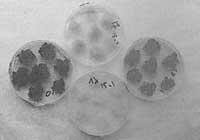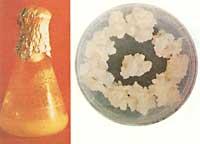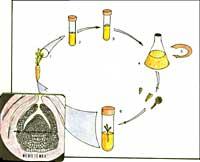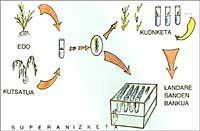Plants not only grow in crop fields
50 years ago he took his first steps, has left the world of science fiction to become a revolutionary agricultural method. Today, thanks to researchers from different laboratories around the world, in vitro growth for the reproduction of plant cells and tissues has reached the commercial phase.

In fact, in some laboratories this technique has become a common practice. From a single plant, a harvest of thousands of specimens that are twins is periodically obtained: biological reproduction has reached infinity.
On other occasions, an enormous effort is being made to create new suitable plant or hybrid species between two different species.
At the same time, the exclusion of viral diseases that infected certain types of plants has become a daily job. Banks of specimen plants that keep specimens without viral contamination are prepared for farmers.
Perhaps the first three direct applications that can be more spectacular in the field of probete plants. Despite the serious problems that arise in the section, we will try to analyze that in vitro growth gives us other advantages.
If we had approached our grandparents when we were dressed with their potato and tomato plants from their garden, we told them that we could create a plant that would bear fruit together, before they told us anything, they would have taken the excuse and answered us to start working next door. Another thing would be that the plant out of rust, is a healthy plant without viruses.
This story, or similar, has today been a reality by biotechnologists. The method of in vitro cultivation of some commercial plants is already carried out systematically.
This specific field of biotechnology, which in many cases is known by analogy with the concept of probeta-ume as a method of the probete plant, will provide or acquire the following advantages and improvements:
- The techniques classically used in plant reproduction are too slow, so the in vitro growth method is revolutionizing enormously. In addition to obtaining the infinity of ugalmas of a single plant (which has reduced the production time and the cost), it has managed to eliminate viral diseases that polluted the same plant, improving the sanitary quality of the plants. Meanwhile, research carried out by both mutants and somatic hybrids in another section of plant production, specifically in the field of plant genetic improvement,
has made this system of great importance.
Moreover, what until now was impossible has become a reality: the growth of haploid individuals can be achieved. That is, starting from sexual cells (anthers, microspores, etc.) whole plants can be formed with half the normal genetic endowment. We cannot forget that, going to
another level, it facilitates research on morphogenetic responses in the scientific field. Finally,
and as a hypothesis, if at the moment a large number of isolated products of tropical plants (drugs, pesticides and aromatizers) are needed, their production will be achieved on an industrial scale, cultivating plant cells in fermentation vessels, as do microbiologists.
A little history
It seems so striking that before we begin to analyze how we can make reproduction, let us recognize its bases. Let's mention something about the history (albeit roughly) of the ideas that have made this technique possible.

We come for this to the year in which the bibliography presents us with origin. At the beginning of this century, around 1902, the researcher Haberland came up with the fact that the plant cell could be totally totipotent, that is, this scientist said that the somatic cell was able to regenerate the whole plant.
Although he tried to isolate and grow maize cells, he did not achieve any experimental success. The main causes of bankruptcy could be, on the one hand, the inadequacy of the cotyledofluvial plant that it chose for its work (corn is actually quite inappropriate for in vitro reproduction) and, on the other, the lack of use of regulatory growth factors or growth, as demonstrated later.
The second step, according to Hanning, was taken two years later, when he managed to isolate the embryo from a plant of the crucifixion group and grow in vitro.
During the investigations, in 1934, White discovered that it was possible to cultivate tomato roots without any other organ. In those research papers he used yeast extracts as a source of food for cells. During the sessions he showed that vitamin B was mandatory.
However, until 1946 total plant regeneration was not achieved: R. Bell in USA, Lupinus sp. cultivating the vertices of the plant stem achieved for the first time a complete regeneration with good results.
Before this successful work, ten years earlier, it was observed that auxins (chemical derivatives of indolacetic acid) had a special incidence in plant cultivation, which were identified as regulatory crops through different experiments.
Related to this latest discovery and E. As pioneers of Bell's work, we know that while Gautheret and Nobecourt investigated the carrot in this plant and that the behavior of this hormonal group caused a bean to occur in vitro tumor.
Later, in 1952, G, an unforgettable event occurred in the history of the plants of probetas. Morel and C. The French (who tried to verify that the meristemic tissue of the plants was a harmless part to the attacks of the viruses) only cultivated the vegetable vertices, from the dayas contaminated with three types of viruses, able to cultivate new plants without remnants of these diseases. It should be noted that the characteristics of the ripe covers remained completely normal.

beginning of the culture is to introduce (1) part of the chosen virus-clean organ into the tube containing a hormonal medium (2). In your case, you have a single hormone (acetic indol in our example) and will create a structure called bean (3), which will cause cell proliferation.
In the second step (4), through slow agitation, the cells are isolated and, passing through a sieve, the isolated cells separate. They
are then placed in a medium with the second hormone, benzyladenine (cytokinin). Each cell reproduces and grows by difference until it acquires the small plant form with roots, stems and leaves (6).
All this is due to the totipotency of the cell, that is, to the capacity of the plant cell to globally express the potentiality of its genomic. 5 represents the replanting of cell culture.
From there, without weakening the force of skepticism, many researchers have tried to apply the method to a large number of plant types.
All these experimental works have resulted in data and results of all types and sizes.
What is this form of reproduction?
The plant system of specimens is based on the natural form of reproduction: vegetative reproduction.
Against what happens in reproduction through sexual cells, in this form of reproduction only mitosis participates. The somatic stem cell produces genetically identical breeding cells as descendants, while being genetically equal to the father.
Thus, it accepts the expansion of individuals genetically identical to those of any vegetative reproduction, removing homogeneous clones from the mother plant.
In any case, in addition to the mitotic process of regeneration of the entire plant, cellular differentiation and adequate organogenesis are necessary. Although the first one is achieved with some ease, the two neighbors have brought with them a lot of heads.
Most experts working on this specific vegetative reproduction of plants usually classify the stages of development of the process as:
For example, it is known that rhizogenesis (root bud regeneration) can only be due to the placement of auxin or that the addition of this hormone in small amounts and the high concentration of cytokinin induce the morphogenesis of the outbreak during the trial.
It should also be said that today the area of plant hormones is still quite unknown to us. And all the works and uses done so far have been empirical. According to some authors, the analogy between these chemical groups and animal hormones has been excessive, at least when proposing research approaches.
But growth factors are not the only substances present in the cultural medium of the essay: In general, it is necessary to add water, mineral salts, sugars, certain vitamins and organic acids, as well as solutions to maintain a suitable pH.
However, in many cases, both the work and the type of plant do not require a great specificity, so the replacement of such expensive and expensive areas is done by yeast extracts.

Subsequently, all foods are subjected to a typical treatment in works of microbiology: they are mixed with a lingirent substance of agar-agar to give consistency.
Deep sterilization will be performed to have the material ready. In addition to paying special attention to this obligatory step, for the experiment to be a success, it is necessary that throughout the activity we take important measures of asepsis.
The reason for this is evident if we look at the ingredients list of the growing media: it would be difficult to find an environment made up of foods so rich in nutrients for the growth of a high number of microorganisms.
Therefore, the lighted breeding rooms will be sterilized and instead of using the classical sowing bell, we will have to take special care in the special laminar flow bell.
Ugalmena without limits: overmultiplication
Around 1960, the possibility was observed that the plants created by meristemas were fragmented into microramas and repeatedly implanted in the new cultural environment. If the whole process was carried out with the right frequency, thousands of new specimens could be created from a single pioneer.
Thanks to this new option, healthy clones have been preserved in sessions, so that in a small space a bank of specimens of healthy goals can be organized.
Problems
For the application of this system to be extended in fruit trees, research advances.
Currently, due to the speed offered by the method, in countries where the system is extended (A.E.F., USA, Japan and France) plant technicians have used the cultivation of specimens. They are dedicated to the reproduction of the best clones of oaks, walnuts and types of oaks of interest.

However, progress in tree work is slower. Because the woody plant is more complex than that of the grass, we want and need a better knowledge of the physiology and biochemistry of the development of the former. Moreover, when these trees are planted in forests in the long term, it would be too dangerous to use this reproductive pathway while not knowing in detail the advantages offered by the new material obtained with in vitro versus traditional techniques.
It is mandatory to grow a number and type of rich clones, especially in the case of forest species, to ensure genetic heterogeneity. If it were not so, since all the specimens are identical, if there were any changes in the environment or if there were any plague, all the specimens would respond in the same way, we would have a disaster.
The simplicity and profitability of cloning, together with the reduction of genetic characteristics, would mean a desired ecological catastrophe.
As a consequence of the use of chemical and physical mutagens, we will comment on one of the most spectacular achievements already announced in the field of genetic improvement, without the intention of deepening too much. A team of biologists from a University of Minnesota has created and developed a new variety of toxin-resistant care from a microscopic fungus that attacked corn leaves. The incorporation of the fungal toxin into cell culture and the subsequent selection of conquering embryos achieved this new variety.
There is no doubt that the above are just introductory examples. From now on, thanks to other biotechnologies, such as the development of protoplasts or the creation of this new methodology by genetic engineering, we believe that our traditional activity will be the subject of a great impulse, a revolution.





